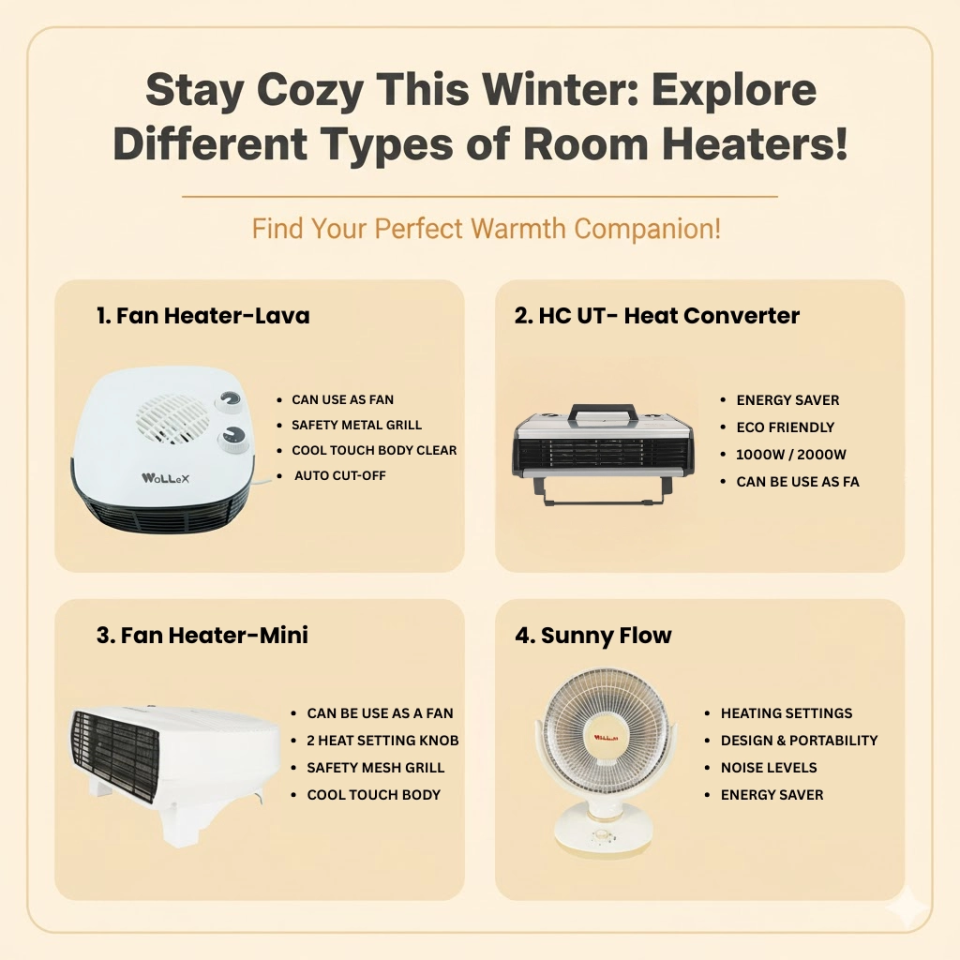
When the winter sets in, the search for warmth becomes dominant in the household. The evenings in the North are miserably cold, the proper selection of a room heater can be the key to being able to endure the cold or to savor warm comfort in fact. There are various types of room heaters in the Indian market- each of them has different mechanisms and advantages. Let us explore these various model types of room heaters in India so that you can select the most suitable one depending on your needs, safety, and cost.
The oil-filled heaters are the best ones with consistent and soft heat. These units are heated by electricity, which heats oil contained by its fins, and the warm air is given into the room, which keeps it cool even after the heater has been turned off.
Best In: Medium and large rooms, children’s rooms, and families during harsh winters in the extreme North of India.
Climate Suitability: Suits well in extreme cold climates (in Northern parts such as Delhi, Himachal Pradesh and Uttarakhand).
Some of the key Characteristics include lack of oxygen burn, humidity and child safety with cool-touch surfaces, ISI certified models increase the safety of their products.
Advantages: It is silent, can be used extensively, it is able to retain longer, and it has low maintenance.
Disadvantages: Expensive initial purchase and heavier than the smaller heaters; they require more time to heat rooms.
Energy consumption: They consume surprisingly less energy when used over a long duration, particularly models that have wattage control options.
Read More: How to Use a Room Heater
Fan heaters (or convectors) operate by blowing warm air past a heated coil and distributing the warm air with the help of a fan.
Best: Small and medium rooms, fast and temporary heating.
Ideal Climate: Work best in moderate winters and a few times- suits West and Central India.
Major Characteristics: Portable, light, instant heating, adjustable settings, ISI certified is available.
Advantage: Wraps up rooms quickly, ideal when spot heating is needed, it is cheap and is extensive.
Disadvantage: It can be loud, it is also likely to dry the air when it is used continuously.
Energy Efficiency: Can be used in the short term, but under controlled use to make electricity bills affordable.
These are radiant heaters, which emit radiant heat directly on objects instead of the air by the use of halogen or quartz rods.
Best in: Small rooms, spot heating - even in very poorly insulated ones.
Climate Suitability: Mild winters, which are good in South Indian or coastal cities where short periods of heating are all that are required.
The main characteristics include instant heat, easy controls
Advantages: Low Noise, low power use, good at targeted warmth.
Disadvantages: Not suitable for big rooms, becomes cold very fast after being turned off.
Safety Timetables: Find safety grills and tip-over protection; avoid children and pets.
Ceramic Heaters
These heaters employ a ceramic heating element to give heat uniformly and effectively. They offer a small size and fast operation.
Best In: Bedrooms, study rooms or office cabins.
Climate Suitability: Moving averagely cool weather and apartment.
Characteristics: Use of less energy, rapid heating, allow ease of transportation.
Advantages: Standardized heating, durable construction and sleek appearance.
Disadvantages: Expensive than the simplest fan heaters, and can only heat a small area.
These heaters are a combination of high-technology heating systems with high-fashion styles that may be mounted on the wall or stand alone. They heat air by convection currents in order to achieve continuous, noise free heating.
Best: Solution: Contemporary houses, small children’s bedrooms, and areas that may require the style.
Ideal Regions: Cities and more recent apartments in India.
Important Characteristics: Online controls, timers, silent working and smooth edges.
Advantages: Noise, compact, and automatic thermostats to save power.
Disadvantage: It requires a longer duration to warm up a large area than a fan heater.
Energy Efficiency: Works best in insulated draft free rooms.
Heaters such as Insta Delight models have several levels of wattages and can be moved easily with light bodies.

Characteristics: Can be adjusted, shockproof casing, winding of the cord and carrying handles.
Best: Small families, renters and those who have to transfer the heaters across rooms often.
Gas Room Heaters: Less popular due to safety reasons and ventilation requirements but can be found in the rural and business environment. They require high levels of care because of the chances of gas leakage and carbon monoxide.
Advice: Do not use it in a majority of home situations,
Wattage vs. Room size: A heater of 800-1500W is adequate in most Indian rooms (100-150 sq. ft.).
Energy Rating Awareness: Select models with more stars will reduce the cost.
Look For Safety Certifications: Look for the ISI label and such features as tip-over protection, safety grills, shockproof cases and insulated cords.
Noise and Portability: Use noiseless models in the bedrooms and in the study areas, give preference to portable models.
Smart Technology: Smart heaters with thermostat, timers or Wi-Fi controllers to make the place as comfortable as you please.
A room-heater can only be of the best kind based on the climate, room space, and family requirements. Multi-setting convection and fan heaters are cost-effective and available to provide instant warmth in a small area, whereas oil-filled radiators provide safe and sustainable warmth to families and overnights. Halogen and ceramic heaters are ideal with mild winters and are used in spot heating. Evaluate the requirements of your home, compare alternatives and select a certified and quality heater.
Ans: Oil-filled radiator heaters are best for bedrooms—they provide consistent warmth, are quiet, and safer for long use.
Ans: Quartz heaters get very hot and can cause burns—keep them away from children and flammable items.
Ans: Fan heaters usually consume 1,000–2,000 watts per hour, depending on the model and temperature setting.
Ans: It’s not recommended. For safety, switch it off before sleeping or use an oil-filled heater with a thermostat and timer.